Generating High-Resolution CT Slices from Two Image Series Using Deep-Learning-Based Resolution Enhancement Methods
Abstract
:1. Introduction
2. Materials and Methods
2.1. Description of Artificial Intelligence (AI) Network Models and their Modification
2.1.1. SRCNN (Super-Resolution Convolutional Neural Network)
2.1.2. VDSR (Very Deep Super Resolution)
2.1.3. SRResNet (Generator Network for SRGAN)
2.1.4. EDSR (Enhanced Deep Residual Network)
2.2. Data Collection
2.3. Image Preprocessing Process
2.4. SR Model Selection and Training
2.5. Testing Procedure
2.6. Quantitative and Statistical Analysis
3. Results
4. Discussion
5. Conclusions
Supplementary Materials
Author Contributions
Funding
Institutional Review Board Statement
Informed Consent Statement
Data Availability Statement
Conflicts of Interest
References
- Fryback, D.G.; Thornbury, J.R. The efficacy of diagnostic imaging. Med. Decis. Mak. 1991, 11, 88–94. [Google Scholar] [CrossRef] [PubMed]
- Adeniji-Sofoluwe, A.-T.; Adekanmi, A.-J.; Efidi, R. Imaging Findings in Chest Computed Tomography: Initial Experience in a Developing Country. Open J. Clin. Diag. 2017, 7, 113. [Google Scholar] [CrossRef] [Green Version]
- Best, A.-C.; Meng, J.; Lynch, A.-M.; Bozic, C.-M.; Miller, D.; Grunwald, G.-K.; Lynch, D.-A. Idiopathic pulmonary fibrosis: Physiologic tests, quantitative CT indexes, and CT visual scores as predictors of mortality. Radiology 2008, 246, 935–940. [Google Scholar] [CrossRef] [PubMed]
- Oh, J.-Y.; Kwon, S.-Y.; Yoon, H.-I.; Lee, S.-M.; Yim, J.-J.; Lee, J.-H.; Yoo, C.-G.; Kim, Y.-W.; Han, S.-K.; Shim, Y.-S.; et al. Clinical significance of a solitary ground-glass opacity (GGO) lesion of the lung detected by chest CT. Lung Cancer 2007, 55, 67–73. [Google Scholar] [CrossRef] [PubMed]
- Achenbach, T.; Weinheimer, O.; Buschsieweke, C.; Heussel, C.-P.; Thelen, M.; Kauczor, H.U. Fully automatic detection and quantification of emphysema on thin section MD-CT of the chest by a new and dedicated software. Fortschr. Geb. Röntgenstrahlen Nukl. Med. 2004, 176, 1409–1415. [Google Scholar] [CrossRef]
- Matsumoto, Y.; Izumo, T.; Sasada, S.; Tsuchida, T.; Ohe, Y. Diagnostic utility of endobronchial ultrasound with a guide sheath under the computed tomography workstation (ziostation) for small peripheral pulmonary lesions. Clin. Respir. J. 2017, 11, 185–192. [Google Scholar] [CrossRef]
- Amanatiadis, A.; Andreadis, I. A survey on evaluation methods for image interpolation. Meas. Sci. Technol. 2009, 20, 104015. [Google Scholar] [CrossRef]
- Puschmann, K.G.; Kneer, F. On super-resolution in astronomical imaging. Astron. Astrophys. 2005, 436, 373–378. [Google Scholar] [CrossRef]
- Onishi, R.; Sugiyama, D.; Matsuda, K. Super-resolution simulation for real-time prediction of urban micrometeorology. Sola 2019, 15, 178–182. [Google Scholar] [CrossRef] [Green Version]
- Mahdy, A.M.S. A numerical method for solving the nonlinear equations of Emden-Fowler models. J. Ocean Eng. Sci. 2022; in press. [Google Scholar] [CrossRef]
- Dong, C.; Loy, C.-C.; He, K.; Tang, X. Image super-resolution using deep convolutional networks. IEEE Trans. Patt. Anal. Mach. Intell. 2015, 38, 295–307. [Google Scholar] [CrossRef] [PubMed] [Green Version]
- Dong, C.; Loy, C.-C.; He, K.; Tang, X. Learning a deep convolutional network for image super-resolution. In Proceedings of the European Conference on Computer Vision, Zurich, Switzerland, 6–12 September 2014; pp. 184–199. [Google Scholar]
- Pham, C.-H.; Ducournau, A.; Fablet, R.; Rousseau, F. Brain MRI super-resolution using deep 3D convolutional networks. In Proceedings of the IEEE Conference on International Symposium on Biomedical Imaging, Melbourne, VIC, Australia, 18–21 April 2017; pp. 197–200. [Google Scholar]
- Wei, S.; Wu, W.; Jeon, G.; Ahmad, A.; Yang, X. Improving resolution of medical images with deep dense convolutional neural network. Concurr. Comput. 2020, 32, e5084. [Google Scholar] [CrossRef]
- Qiu, D.; Cheng, Y.; Wang, X.; Zhang, X. Multi-window back-projection residual networks for reconstructing COVID-19 CT super-resolution images. Comput. Methods Programs Biomed. 2021, 200, 105934. [Google Scholar] [CrossRef] [PubMed]
- Zhang, K.; Hu, H.; Philbrick, K.; Conte, G.-M.; Sobek, J.-D.; Rouzrokh, P.; Erickson, B.-J. SOUP-GAN: Super-resolution MRI using generative adversarial networks. Tomography 2022, 8, 905–919. [Google Scholar] [CrossRef] [PubMed]
- Du, J.; He, Z.; Wang, L.; Gholipour, A.; Zhou, Z.; Chen, D.; Jia, Y. Super-resolution reconstruction of single anisotropic 3D MR images using residual convolutional neural network. Neurocomputing 2020, 392, 209–220. [Google Scholar] [CrossRef]
- Sánchez, I.; Vilaplana, V. Brain MRI super-resolution using 3D generative adversarial networks. arXiv 2018, arXiv:1812.11440. [Google Scholar]
- Zhao, C.; Carass, A.; Dewey, B.-E.; Prince, J.-L. Self super-resolution for magnetic resonance images using deep networks. In Proceedings of the IEEE Conference on International Symposium on Biomedical Imaging, Washington, DC, USA, 4–7 April 2018; pp. 365–368. [Google Scholar]
- Kim, J.; Lee, J.-K.; Lee, K.-M. Accurate image super-resolution using very deep convolutional networks. In Proceedings of the IEEE Conference on Computer Vision and Pattern Recognition, Las Vegas, NV, USA, 27–30 June 2016; pp. 1646–1654. [Google Scholar]
- Ledig, C.; Theis, L.; Huszár, F.; Caballero, J.; Cunningham, A.; Acosta, A.; Aitken, A.; Tejani, A.; Totz, J.; Wang, Z.; et al. Photo-realistic single image super-resolution using a generative adversarial network. In Proceedings of the IEEE Conference on Computer Vision and Pattern Recognition, Honolulu, HI, USA, 21–26 July 2017; pp. 4681–4690. [Google Scholar]
- Lim, B.; Son, S.; Kim, H.; Nah, S.; Mu Lee, K. Enhanced deep residual networks for single image super-resolution. In Proceedings of the IEEE Conference on Computer Vision and Pattern Recognition, Honolulu, HI, USA, 21–26 July 2017; pp. 136–144. [Google Scholar]
- van Rikxoort, E.-M.; de Hoop, B.; Viergever, M.-A.; Prokop, M.; van Ginneken, B. Automatic lung segmentation from thoracic computed tomography scans using a hybrid approach with error detection. Med. Phys. 2009, 36, 2934–2947. [Google Scholar] [CrossRef]
- Hofmanninger, J.; Prayer, F.; Pan, J.; Röhrich, S.; Prosch, H.; Langs, G. Automatic lung segmentation in routine imaging is primarily a data diversity problem, not a methodology problem. Eur. Radiol. Exp. 2020, 4, 50. [Google Scholar] [CrossRef]
- Kingma, D.-P.; Ba, J. Adam: A method for stochastic optimization. arXiv 2014, arXiv:1412.6980. [Google Scholar]
- Nishio, M.; Sugiyama, O.; Yakami, M.; Ueno, S.; Kubo, T.; Kuroda, T.; Togashi, K. Computer-aided diagnosis of lung nodule classification between benign nodule, primary lung cancer, and metastatic lung cancer at different image size using deep convolutional neural network with transfer learning. PLoS ONE 2018, 13, e0200721. [Google Scholar] [CrossRef] [Green Version]
- Liu, X.; Hou, F.; Qin, H.; Hao, A. Multi-view multi-scale CNNs for lung nodule type classification from CT images. Pattern Recognit. 2018, 77, 262–275. [Google Scholar] [CrossRef]
- Setio, A.-A.-A.; Ciompi, F.; Litjens, G.; Gerke, P.; Jacobs, C.; Van Riel, S.-J.; Wille, M.-M.-W.; Naqibullah, M.; Sánchez, C.-I.; Van Ginneken, B. Pulmonary nodule detection in CT images: False positive reduction using multi-view convolutional networks. IEEE Trans. Med. Imaging 2016, 35, 1160–1169. [Google Scholar] [CrossRef] [PubMed]
- Kazem, R.-A.H.; Suad, J.; Abdulbaqi, A. Super-resolution using 3d convolutional neural networks in CT scan image of COVID19. Turk. J. Comput. Math. Educ. 2021, 12, 4408–4415. [Google Scholar]
- Chaudhari, A.-S.; Fang, Z.; Kogan, F.; Wood, J.; Stevens, K.-J.; Gibbons, E.-K.; Lee, J.-H.; Gold, G.-E.; Hargreaves, B.-A. Super-resolution musculoskeletal MRI using deep learning. Magn. Reason. Med. 2018, 80, 2139–2154. [Google Scholar] [CrossRef] [PubMed]
- Zhao, C.; Dewey, B.-E.; Pham, D.-L.; Calabresi, P.-A.; Reich, D.-S.; Prince, J.-L. SMORE: A self-supervised anti-aliasing and super-resolution algorithm for MRI using deep learning. IEEE Trans. Med. Imaging 2020, 40, 805–817. [Google Scholar] [CrossRef] [PubMed]
- Choe, J.; Lee, S.-M.; Do, K.-H.; Lee, G.; Lee, J.-G.; Lee, S.-M.; Seo, J.-B. Deep learning–based image conversion of CT reconstruction kernels improves radiomics reproducibility for pulmonary nodules or masses. Radiology 2019, 292, 365–373. [Google Scholar] [CrossRef] [PubMed]
- Arnold, T.-C.; Baldassano, S.-N.; Litt, B.; Stein, J.-M. Simulated diagnostic performance of low-field MRI: Harnessing open-access datasets to evaluate novel devices. Magn. Reason. Imaging 2022, 87, 67–76. [Google Scholar] [CrossRef] [PubMed]


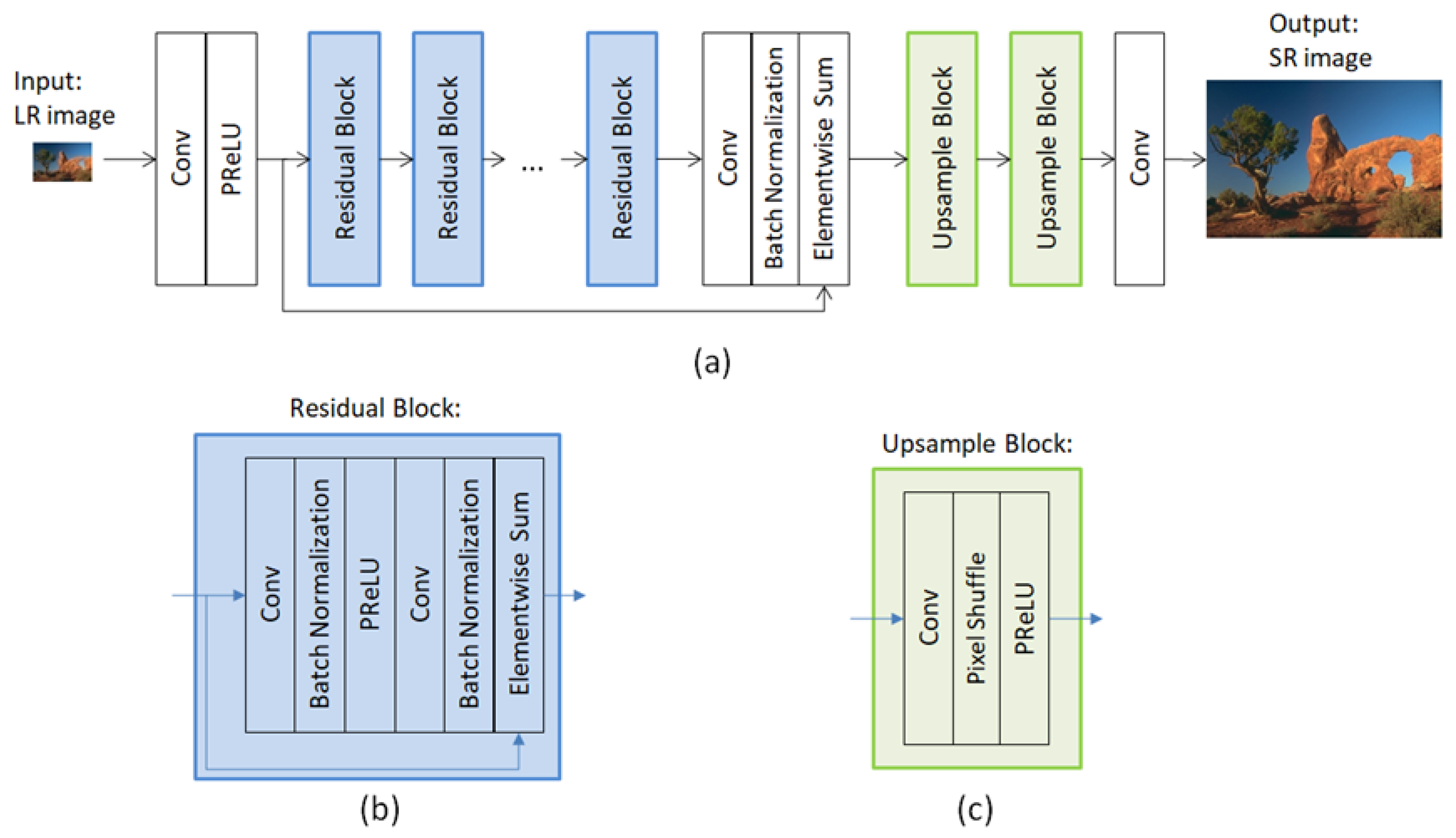
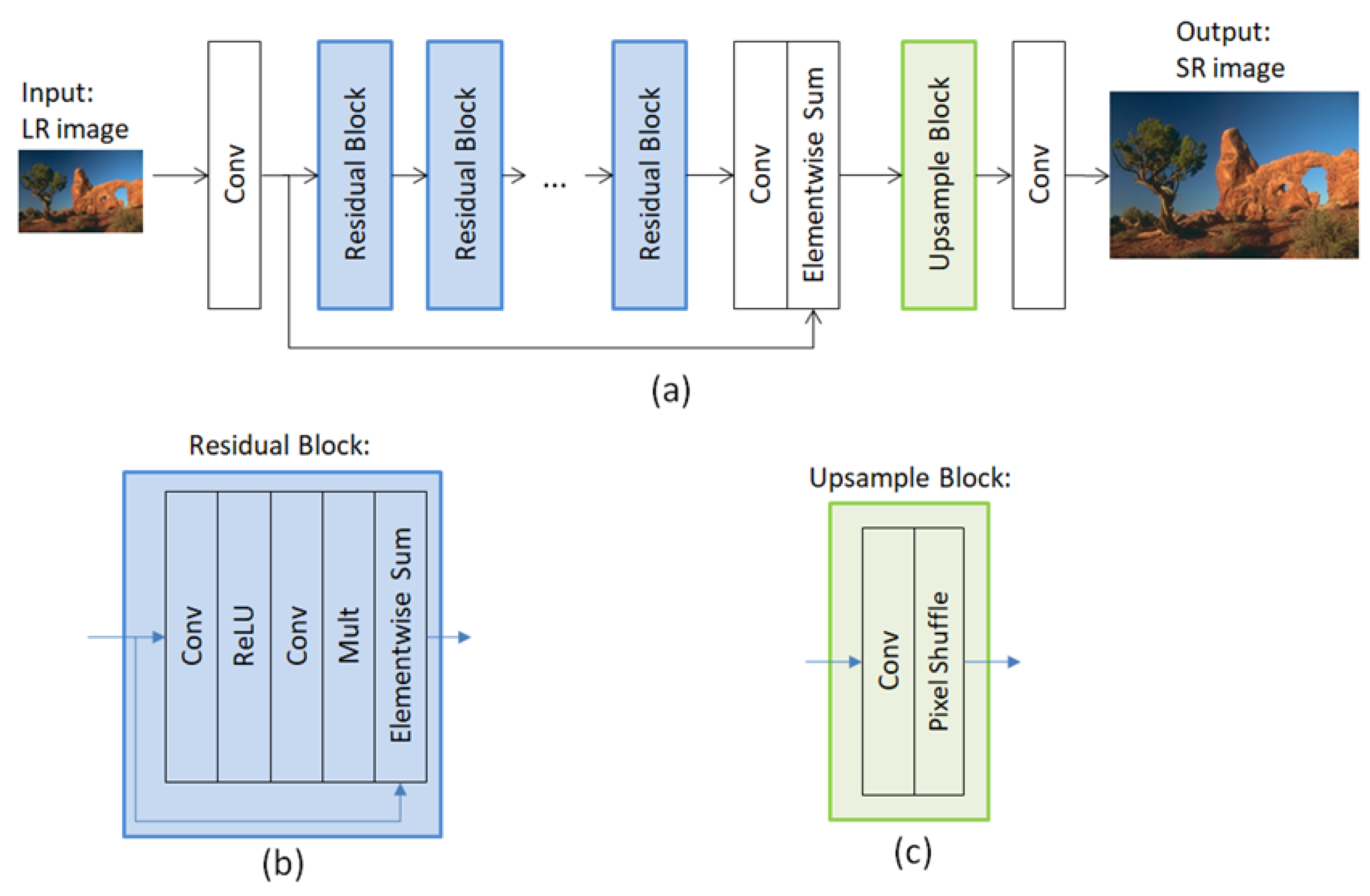

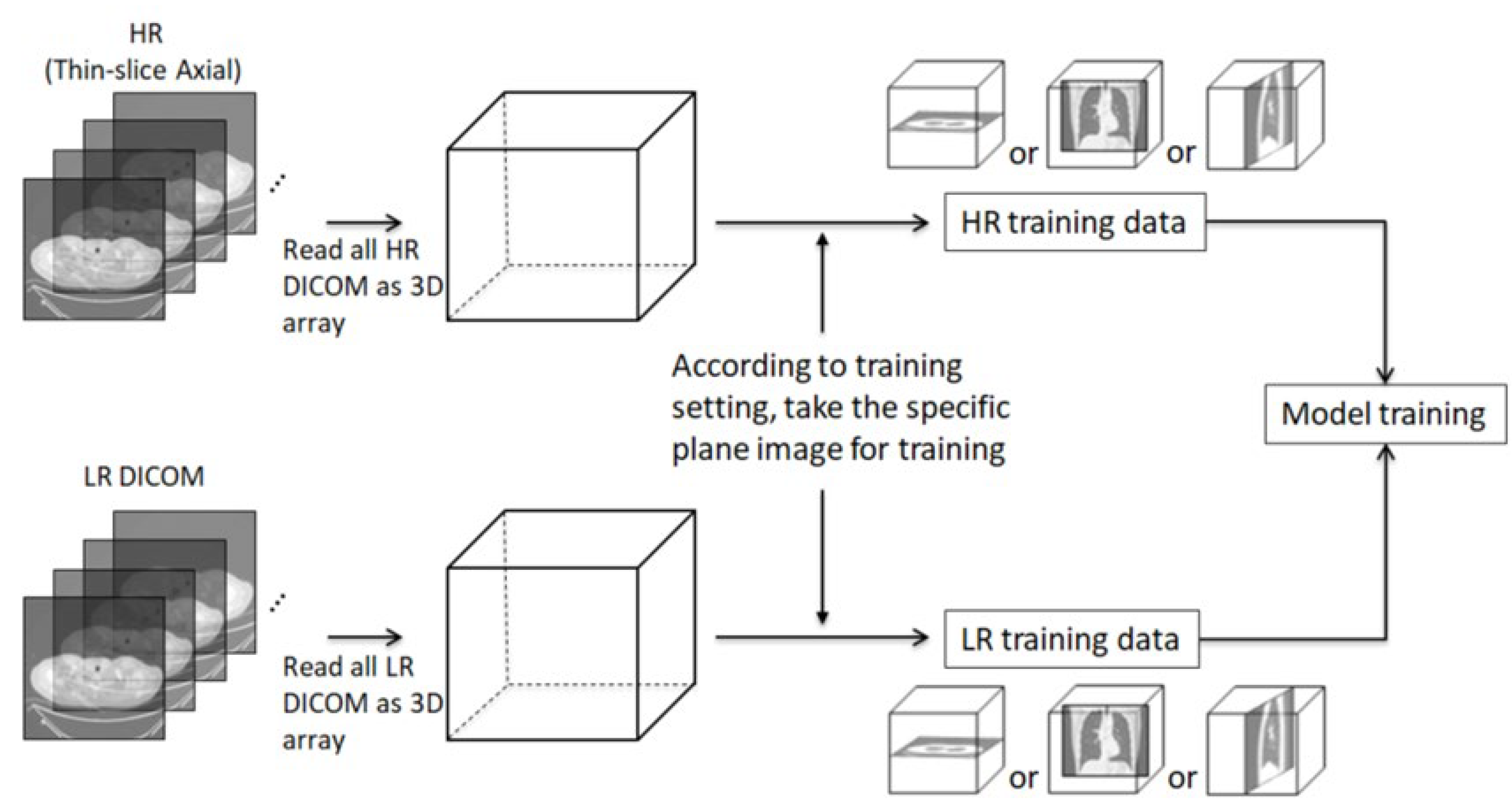
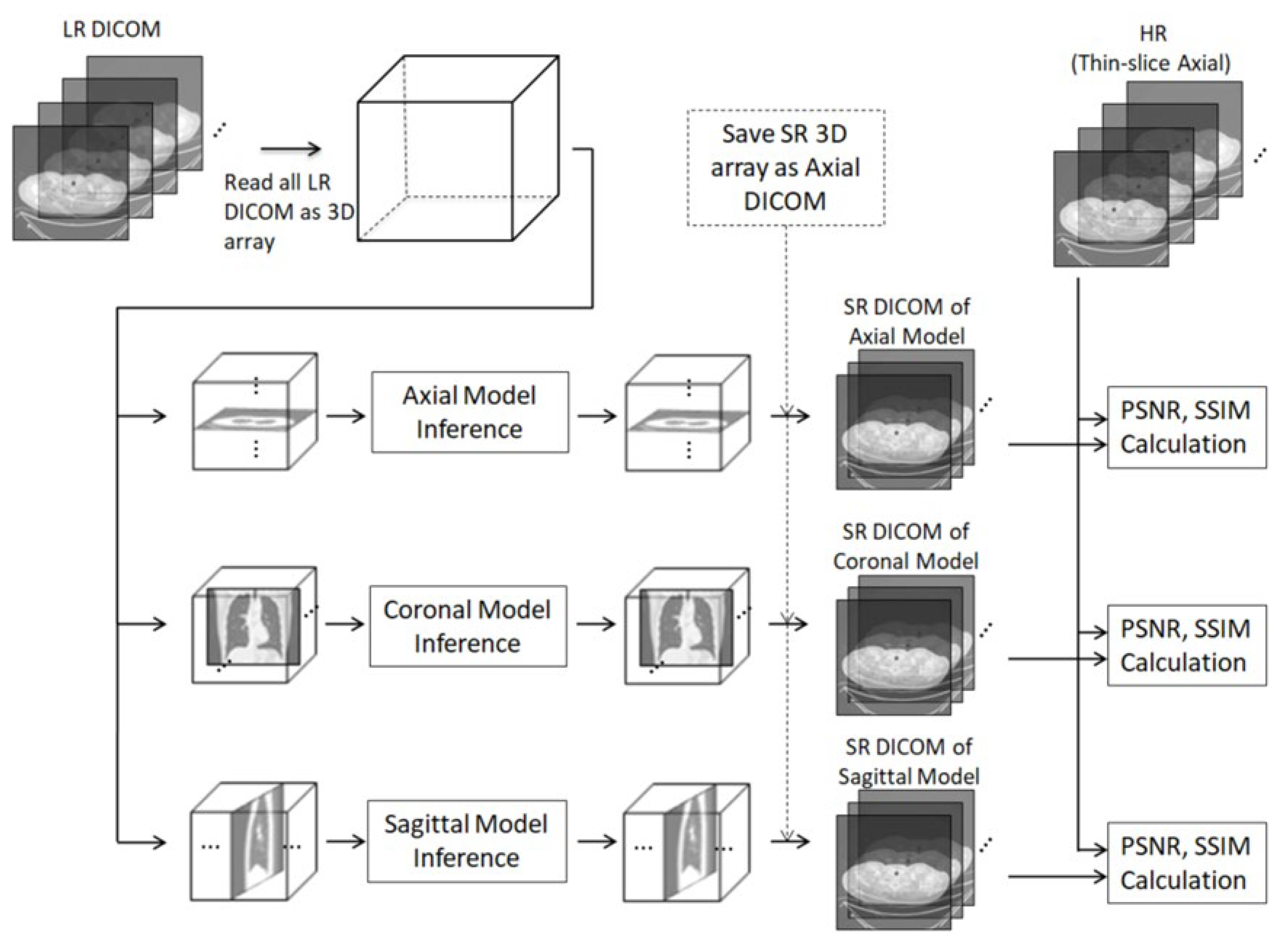

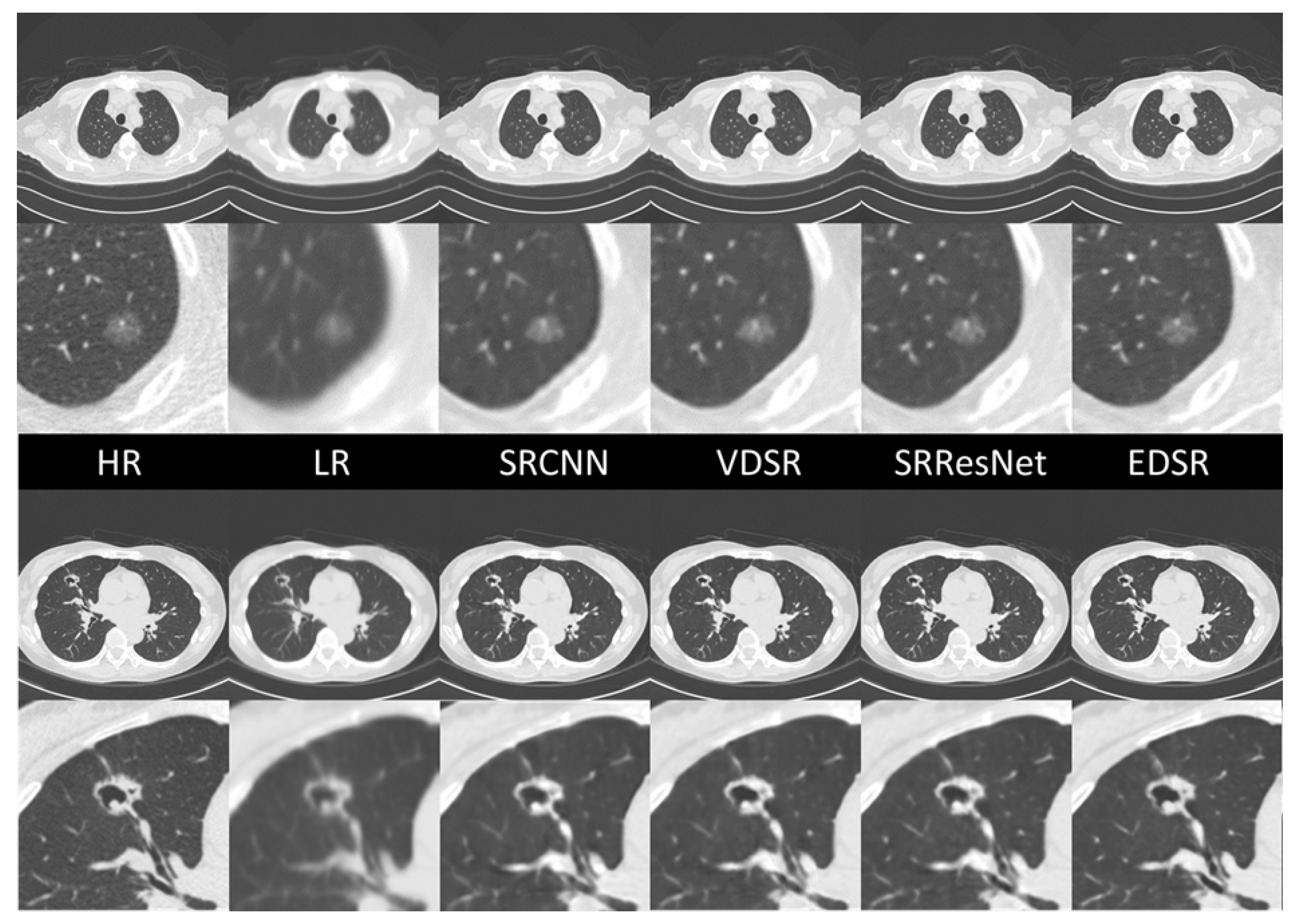
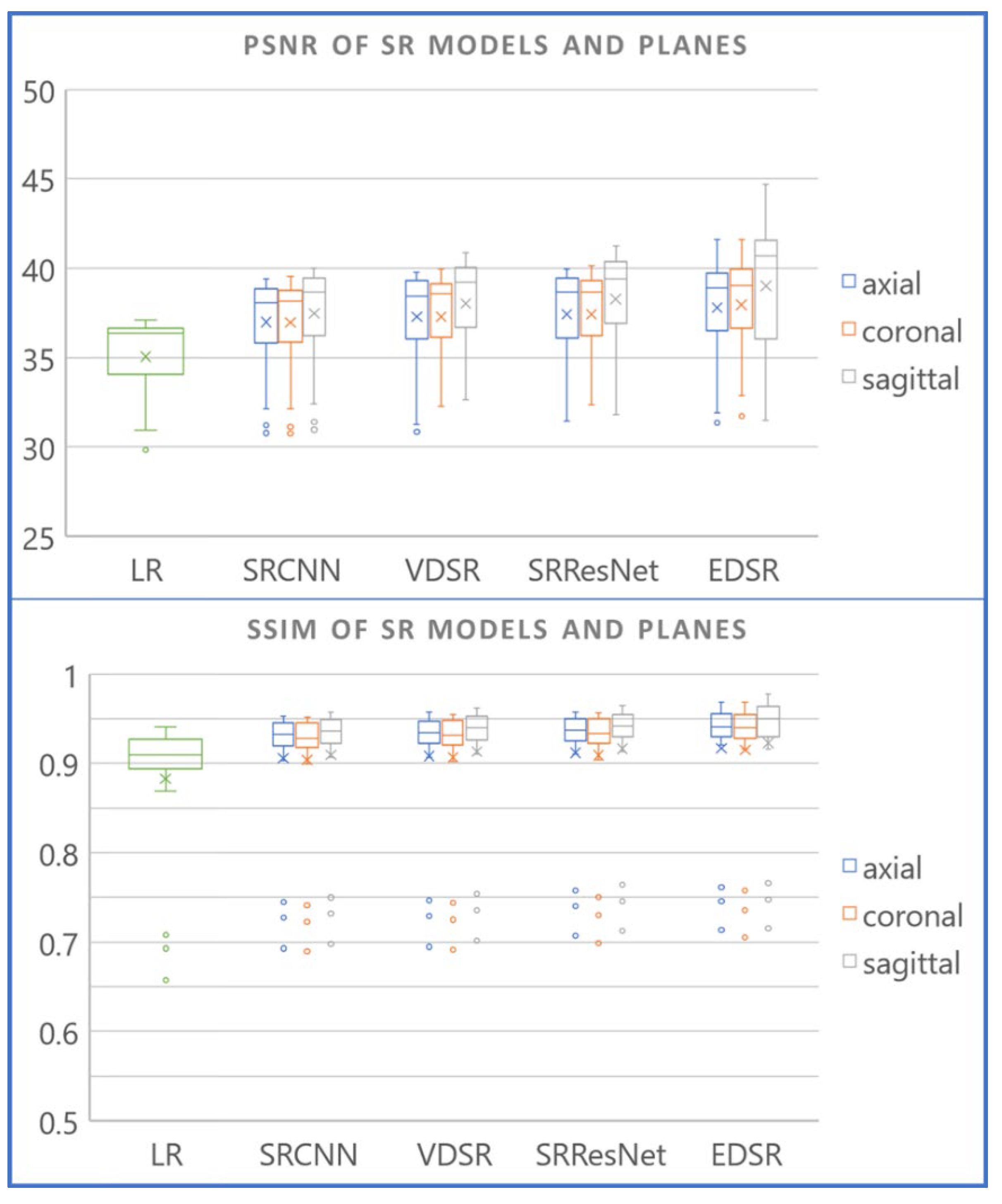
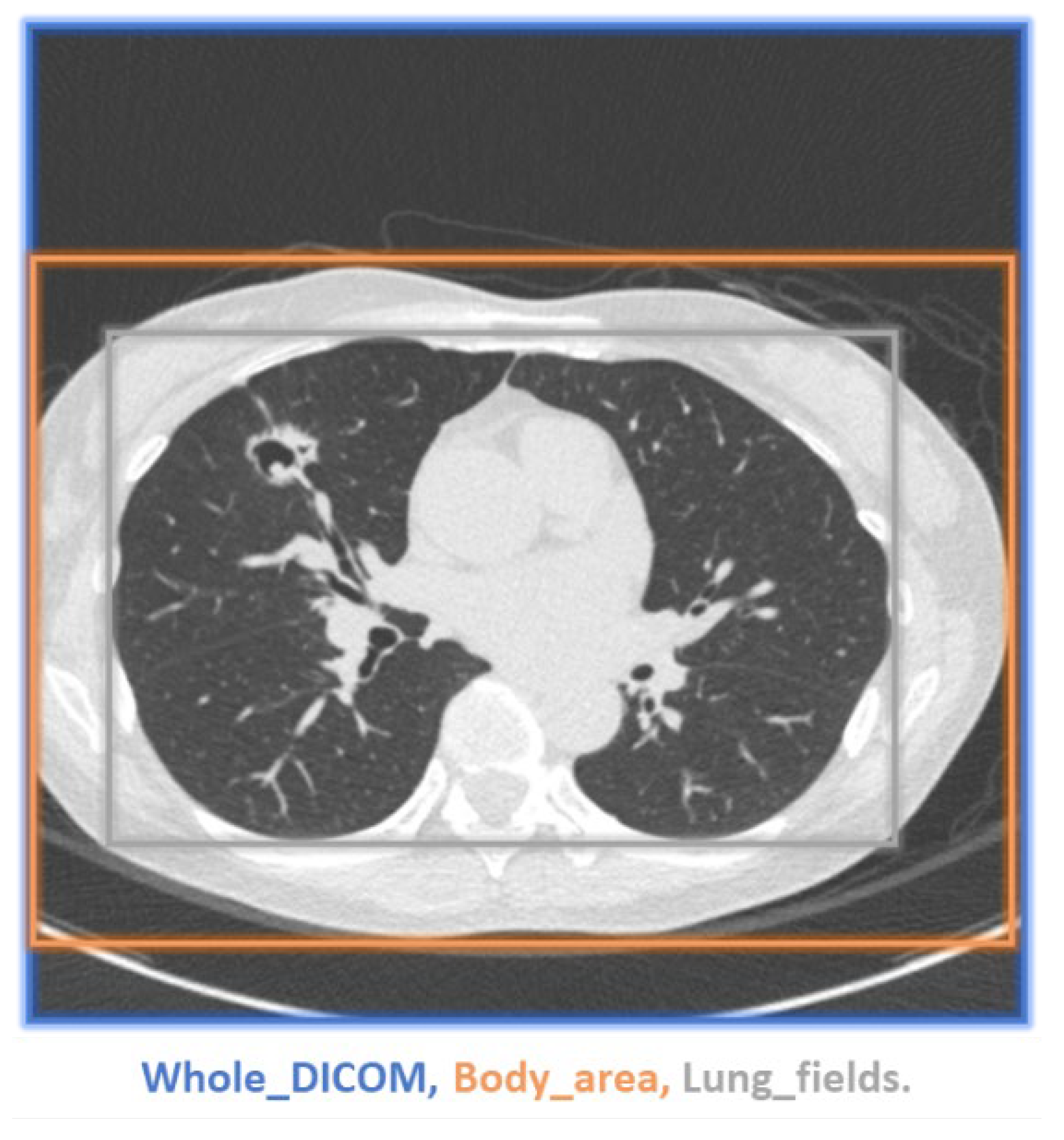
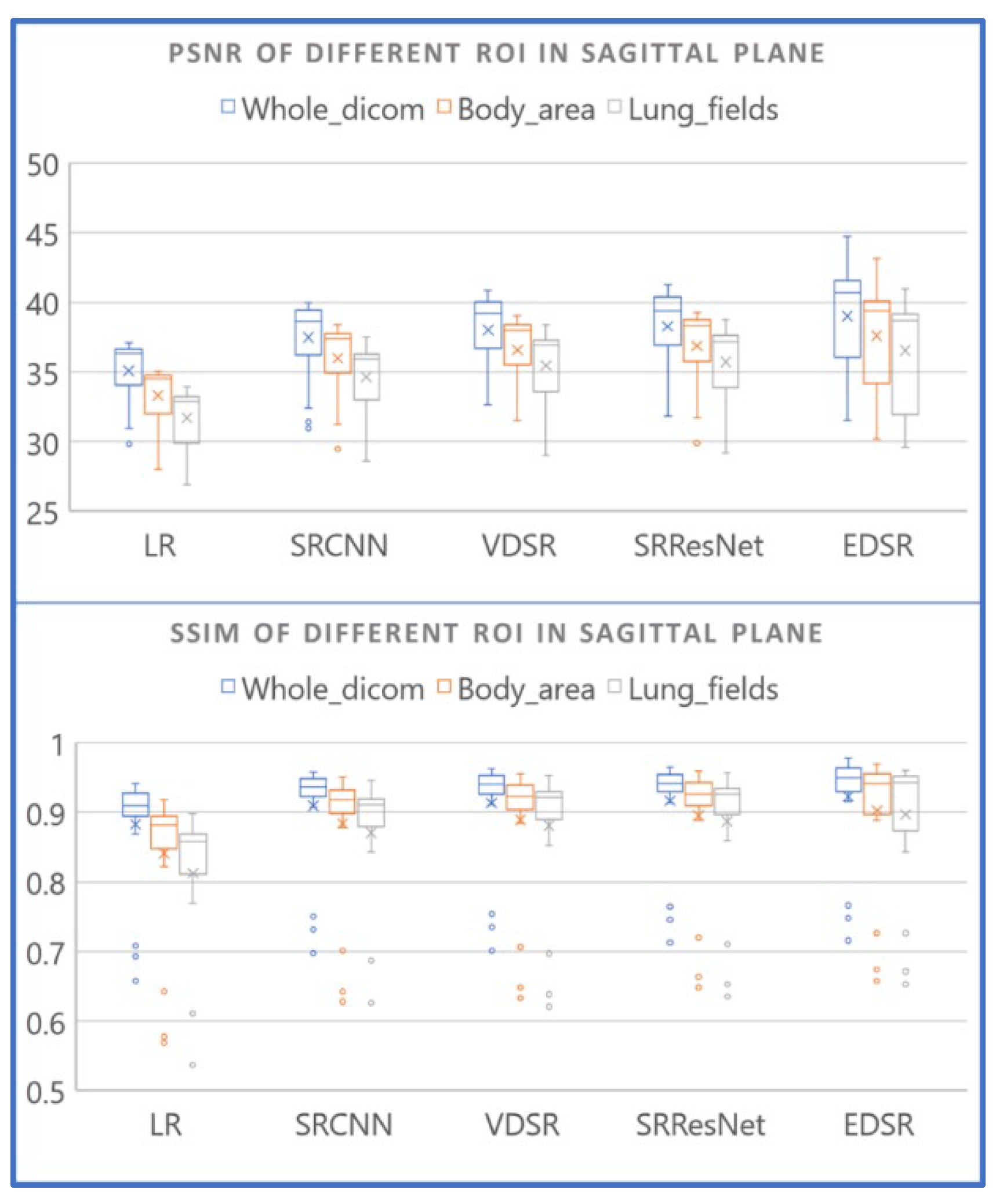
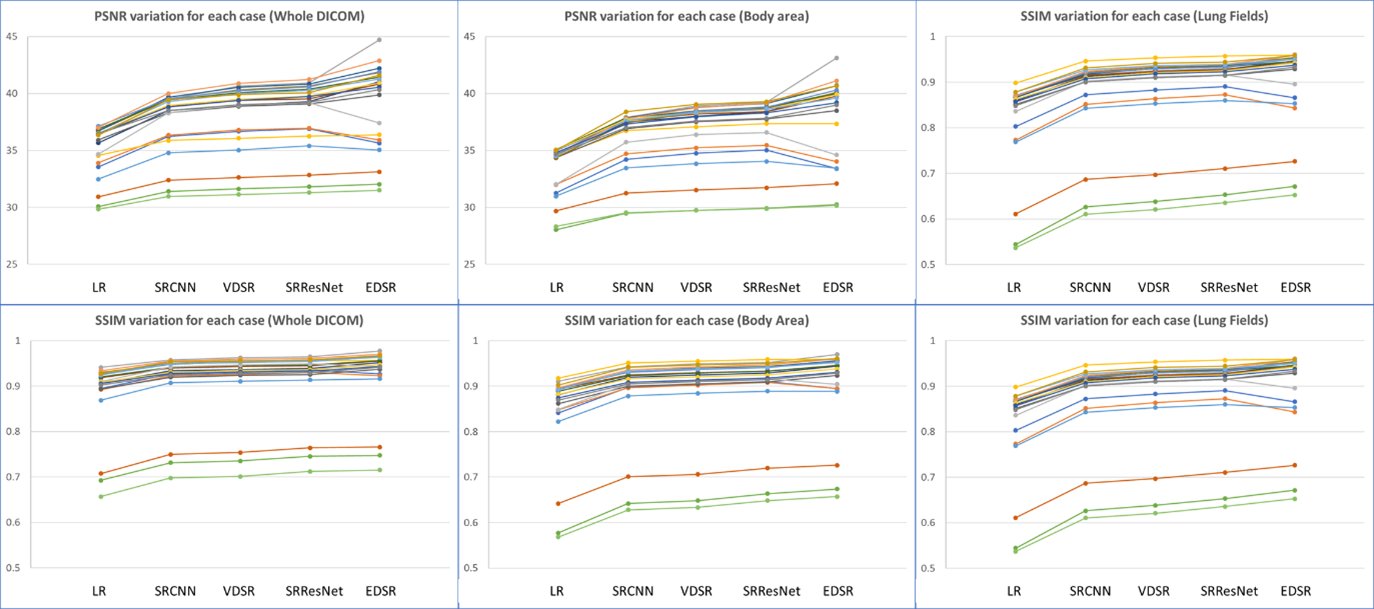
| Type | Plane | Slice Thickness (mm) | Spatial Interval between Neighbor Slice (mm) |
|---|---|---|---|
| Thin-slice | Axial | 1~1.25 | 0.7~1.25 (and should ≤ Slice Thickness) |
| Thick-slice | Axial | 5 | 5 |
| Thick-slice | Coronal | 5 | 5 |
| Model | Patch Size | Batch Size | Batches Per Epoch | Total Epochs | Total Patches Trained | Initial Learning Rate | Loss |
|---|---|---|---|---|---|---|---|
| EDSR | 96 × 96 | 16 | 7500 | 20 | 2,400,000 | 0.0001 | L1 |
| SRCNN | 96 × 96 | 16 | 1000 | 200 | 3,200,000 | 0.0001 | MSE |
| VDSR | 96 × 96 | 16 | 1000 | 240 | 3,840,000 | 0.00001 | MSE |
| SRResNet | 96 × 96 | 16 | 1000 | 180 | 2,880,000 | 0.0001 | MSE |
| Model | Number of GPUs | Number of Data Loader Threads | Training Time (Hours) |
|---|---|---|---|
| EDSR-Axial | 2 | 16 | 34.09 |
| EDSR-Coronal | 2 | 16 | 34.02 |
| EDSR-Sagittal | 2 | 16 | 35.89 |
| SRCNN-Axial | 2 | 16 | 16.33 |
| SRCNN-Coronal | 2 | 16 | 13.00 |
| SRCNN-Sagittal | 2 | 16 | 13.11 |
| VDSR-Axial | 2 | 16 | 19.67 |
| VDSR-Coronal | 2 | 16 | 17.25 |
| VDSR-Sagittal | 2 | 16 | 16.55 |
| SRResNet-Axial | 2 | 16 | 16.53 |
| SRResNet-Coronal | 2 | 16 | 17.86 |
| SRResNet-Sagittal | 2 | 16 | 13.27 |
| Model | Number of GPU | Processing Time (sec/slice) (Inference and Saving Results as DICOM Files) |
|---|---|---|
| EDSR-Axial | 1 | 0.7415 |
| EDSR-Coronal | 1 | 0.5097 |
| EDSR-Sagittal | 1 | 0.5110 |
| SRCNN-Axial | 1 | 0.0836 |
| SRCNN-Coronal | 1 | 0.0704 |
| SRCNN-Sagittal | 1 | 0.0732 |
| VDSR-Axial | 1 | 0.1467 |
| VDSR-Coronal | 1 | 0.1271 |
| VDSR-Sagittal | 1 | 0.1398 |
| SRResNet-Axial | 1 | 0.1814 |
| SRResNet-Coronal | 1 | 0.1300 |
| SRResNet-Sagittal | 1 | 0.1273 |
| (a) | |||||
|---|---|---|---|---|---|
| LR | SRCNN | VDSR | SRResNet | EDSR | |
| axial | 35.066 | 36.988 | 37.280 | 37.430 | 37.786 |
| coronal | 35.066 | 36.958 | 37.279 | 37.426 | 37.948 |
| sagittal | 35.066 | 37.479 | 38.026 | 38.281 | 39.021 |
| (b) | |||||
| LR | SRCNN | VDSR | SRResNet | EDSR | |
| axial | 0.8827 | 0.9058 | 0.9080 | 0.9118 | 0.9171 |
| coronal | 0.8827 | 0.9038 | 0.9067 | 0.9091 | 0.9149 |
| sagittal | 0.8827 | 0.9094 | 0.9132 | 0.9165 | 0.9227 |
| PSNR | LR | SRCNN | SRCNN | SRCNN | VDSR | VDSR | VDSR | SRResNet | SRResNet | SRResNet | EDSR | EDSR | EDSR | |
|---|---|---|---|---|---|---|---|---|---|---|---|---|---|---|
| Axial | Coronal | Sagittal | Axial | Coronal | Sagittal | Axial | Coronal | Sagittal | Axial | Coronal | Sagittal | |||
| LR | 2.38 × 10−7 | 2.38 × 10−7 | 2.38 × 10−7 | 2.38 × 10−7 | 2.38 × 10−7 | 2.38 × 10−7 | 2.38 × 10−7 | 2.38 × 10−7 | 2.38 × 10−7 | 2.38 × 10−7 | 2.38 × 10−7 | 2.38 × 10−7 | ||
| SRCNN | axial | 1.38 × 10−1 | 2.38 × 10−7 | 4.77 × 10−7 | 2.14 × 10−4 | 2.38 × 10−7 | 2.38 × 10−7 | 1.07 × 10−4 | 2.38 × 10−7 | 4.71 × 10−4 | 2.38 × 10−7 | 2.38 × 10−6 | ||
| SRCNN | coronal | 2.38 × 10−7 | 6.03 × 10−5 | 2.38 × 10−7 | 2.38 × 10−7 | 4.77 × 10−7 | 2.38 × 10−7 | 2.38 × 10−7 | 2.96 × 10−4 | 2.38 × 10−7 | 1.19 × 10−6 | |||
| SRCNN | sagittal | 1.00 | 1.00 | 2.38 × 10−7 | 9.54 × 10−1 | 2.51 × 10−1 | 2.38 × 10−7 | 2.50 × 10−2 | 7.87 × 10−6 | 3.27 × 10−5 | ||||
| VDSR | axial | 7.80 × 10−2 | 2.38 × 10−7 | 2.38 × 10−7 | 5.16 × 10−3 | 2.38 × 10−7 | 2.96 × 10−3 | 1.67 × 10−5 | 1.67 × 10−5 | |||||
| VDSR | coronal | 2.38 × 10−7 | 2.94 × 10−1 | 2.38 × 10−7 | 2.38 × 10−7 | 1.04 × 10−2 | 2.38 × 10−7 | 1.67 × 10−6 | ||||||
| VDSR | sagittal | 1.00 | 1.00 | 2.38 × 10−7 | 8.40 × 10−1 | 9.17 × 10−1 | 4.71 × 10−4 | |||||||
| SRResNet | axial | 4.27 × 10−2 | 2.38 × 10−7 | 6.36 × 10−3 | 1.07 × 10−4 | 2.10 × 10−5 | ||||||||
| SRResNet | coronal | 2.38 × 10−7 | 3.42 × 10−2 | 2.38 × 10−7 | 7.87 × 10−6 | |||||||||
| SRResNet | sagittal | 9.95 × 10−1 | 1.00 | 5.16 × 10−3 | ||||||||||
| EDSR | axial | 1.94 × 10−1 | 1.62 × 10−3 | |||||||||||
| EDSR | coronal | 2.96 × 10−4 | ||||||||||||
| EDSR | sagittal | |||||||||||||
| SSIM | LR | SRCNN | SRCNN | SRCNN | VDSR | VDSR | VDSR | SRResNet | SRResNet | SRResNet | EDSR | EDSR | EDSR | |
| Axial | Coronal | Sagittal | Axial | Coronal | Sagittal | Axial | Coronal | Sagittal | Axial | Coronal | Sagittal | |||
| LR | 2.38 × 10−7 | 2.38 × 10−7 | 2.38 × 10−7 | 2.38 × 10−7 | 2.38 × 10−7 | 2.38 × 10−7 | 2.38 × 10−7 | 2.38 × 10−7 | 2.38 × 10−7 | 2.38 × 10−7 | 2.38 × 10−7 | 2.38 × 10−7 | ||
| SRCNN | axial | 1.00 | 2.38 × 10−7 | 2.38 × 10−7 | 1.26 × 10−2 | 2.38 × 10−7 | 2.38 × 10−7 | 3.27 × 10−5 | 2.38 × 10−7 | 2.38 × 10−7 | 2.38 × 10−7 | 2.38 × 10−7 | ||
| SRCNN | coronal | 2.38 × 10−7 | 2.38 × 10−7 | 2.38 × 10−7 | 2.38 × 10−7 | 2.38 × 10−7 | 2.38 × 10−7 | 2.38 × 10−7 | 2.38 × 10−7 | 2.38 × 10−7 | 2.38 × 10−7 | |||
| SRCNN | sagittal | 1.00 | 1.00 | 2.38 × 10−7 | 2.10 × 10−5 | 5.25 × 10−1 | 2.38 × 10−7 | 4.53 × 10−6 | 2.38 × 10−7 | 4.77 × 10−7 | ||||
| VDSR | axial | 9.44 × 10−1 | 2.38 × 10−7 | 2.38 × 10−7 | 5.74 × 10−3 | 2.38 × 10−7 | 1.19 × 10−6 | 4.77 × 10−7 | 4.77 × 10−7 | |||||
| VDSR | coronal | 2.38 × 10−7 | 2.38 × 10−7 | 2.38 × 10−7 | 2.38 × 10−7 | 7.15 × 10−7 | 2.38 × 10−7 | 2.38 × 10−7 | ||||||
| VDSR | sagittal | 9.86 × 10−1 | 1.00 | 2.38 × 10−7 | 1.25 × 10−3 | 5.46 × 10−4 | 3.34 × 10−6 | |||||||
| SRResNet | axial | 1.00 | 2.38 × 10−7 | 1.67 × 10−5 | 8.36 × 10−4 | 3.34 × 10−6 | ||||||||
| SRResNet | coronal | 2.38 × 10−7 | 3.34 × 10−6 | 2.38 × 10−7 | 2.38 × 10−7 | |||||||||
| SRResNet | sagittal | 2.03 × 10−1 | 9.87 × 10−1 | 1.07 × 10−4 | ||||||||||
| EDSR | axial | 9.75 × 10−1 | 8.36 × 10−4 | |||||||||||
| EDSR | coronal | 1.03 × 10−5 | ||||||||||||
| EDSR | sagittal |
| (a) | |||||
|---|---|---|---|---|---|
| LR | SRCNN | VDSR | SRResNet | EDSR | |
| whole-DICOM | 35.066 | 37.479 | 38.026 | 38.281 | 39.021 |
| body-area | 33.314 | 35.987 | 36.590 | 36.865 | 37.609 |
| lung-fields | 31.709 | 34.640 | 35.459 | 35.730 | 36.558 |
| (b) | |||||
| LR | SRCNN | VDSR | SRResNet | EDSR | |
| whole-DICOM | 0.8827 | 0.9094 | 0.9132 | 0.9165 | 0.9227 |
| body-area | 0.8409 | 0.8838 | 0.8894 | 0.8950 | 0.9029 |
| lung-fields | 0.8124 | 0.8707 | 0.8811 | 0.8871 | 0.8966 |
| PSNR | LR | LR | LR | SRCNN | SRCNN | SRCNN | VDSR | VDSR | VDSR | SRResNet | SRResNet | SRResNet | EDSR | EDSR | EDSR |
|---|---|---|---|---|---|---|---|---|---|---|---|---|---|---|---|
| Lung | Body | Whole | Lung | Body | Whole | Lung | Body | Whole | Lung | Body | Whole | Lung | Body | Whole | |
| LR Lung_fields | 2.38 × 10−7 | 2.38 × 10−7 | 2.38 × 10−7 | 2.38 × 10−7 | 2.38 × 10−7 | 2.38 × 10−7 | |||||||||
| LR Body_area | 2.38 × 10−7 | 2.38 × 10−7 | 2.38 × 10−7 | 2.38 × 10−7 | 2.38 × 10−7 | ||||||||||
| LR Whole_dicom | 2.38 × 10−7 | 2.38 × 10−7 | 2.38 × 10−7 | 2.38 × 10−7 | |||||||||||
| SRCNN Lung_fields | 7.15 × 10−7 | 4.77 × 10−7 | 2.38 × 10−7 | 2.38 × 10−7 | 4.03 × 10−5 | ||||||||||
| SRCNN Body_area | 4.77 × 10−7 | 2.38 × 10−7 | 2.38 × 10−7 | 7.32 × 10−5 | |||||||||||
| SRCNN Whole_dicom | 2.38 × 10−7 | 2.38 × 10−7 | 3.27 × 10−5 | ||||||||||||
| VDSR Lung_fields | 3.27 × 10−5 | 3.34 × 10−6 | 2.38 × 10−7 | 2.96 × 10−3 | |||||||||||
| VDSR Body_area | 1.19 × 10−6 | 2.38 × 10−7 | 1.10 × 10−3 | ||||||||||||
| VDSR Whole_dicom | 2.38 × 10−7 | 4.71 × 10−4 | |||||||||||||
| SRResNet Lung_fields | 3.27 × 10−5 | 1.67 × 10−5 | 1.64 × 10−2 | ||||||||||||
| SRResNet Body_area | 1.67 × 10−6 | 1.51 × 10−2 | |||||||||||||
| SRResNet Whole_dicom | 5.16 × 10−3 | ||||||||||||||
| EDSR Lung_fields | 4.94 × 10−5 | 7.87 × 10−6 | |||||||||||||
| EDSR Body_area | 1.19 × 10−6 | ||||||||||||||
| EDSR Whole_dicom | |||||||||||||||
| SSIM | LR | LR | LR | SRCNN | SRCNN | SRCNN | VDSR | VDSR | VDSR | SRResNet | SRResNet | SRResNet | EDSR | EDSR | EDSR |
| Lung | Body | Whole | Lung | Body | Whole | Lung | Body | Whole | Lung | Body | Whole | Lung | Body | Whole | |
| LR Lung_fields | 2.38 × 10−7 | 2.38 × 10−7 | 2.38 × 10−7 | 2.38 × 10−7 | 2.3 × 10−7 | 2.38 × 10−7 | |||||||||
| LR Body_area | 2.38 × 10−7 | 2.38 × 10−7 | 2.38 × 10−7 | 2.38 × 10−7 | 2.38 × 10−7 | ||||||||||
| LR Whole_dicom | 2.38 × 10−7 | 2.38 × 10−7 | 2.38 × 10−7 | 2.38 × 10−7 | |||||||||||
| SRCNN Lung_fields | 4.77 × 10−7 | 2.38 × 10−7 | 2.38 × 10−7 | 2.38 × 10−7 | 3.34 × 10−6 | ||||||||||
| SRCNN Body_area | 4.77 × 10−7 | 2.38 × 10−7 | 2.38 × 10−7 | 3.34 × 10−6 | |||||||||||
| SRCNN Whole_dicom | 2.38 × 10−7 | 2.38 × 10−7 | 4.77 × 10−7 | ||||||||||||
| VDSR Lung_fields | 1.81 × 10−4 | 4.77 × 10−7 | 2.38 × 10−7 | 1.28 × 10−4 | |||||||||||
| VDSR Body_area | 4.77 × 10−7 | 2.38 × 10−7 | 1.67 × 10−5 | ||||||||||||
| VDSR Whole_dicom | 2.38 × 10−7 | 3.34 × 10−6 | |||||||||||||
| SRResNet Lung_fields | 2.96 × 10−4 | 4.77 × 10−7 | 1.79 × 10−2 | ||||||||||||
| SRResNet Body_area | 4.77 × 10−7 | 4.64 × 10−3 | |||||||||||||
| SRResNet Whole_dicom | 1.07 × 10−4 | ||||||||||||||
| EDSR Lung_fields | 2.71 × 10−2 | 4.77 × 10−7 | |||||||||||||
| EDSR Body_area | 4.77 × 10−7 | ||||||||||||||
| EDSR Whole_dicom |
Publisher’s Note: MDPI stays neutral with regard to jurisdictional claims in published maps and institutional affiliations. |
© 2022 by the authors. Licensee MDPI, Basel, Switzerland. This article is an open access article distributed under the terms and conditions of the Creative Commons Attribution (CC BY) license (https://creativecommons.org/licenses/by/4.0/).
Share and Cite
Chao, H.-S.; Wu, Y.-H.; Siana, L.; Chen, Y.-M. Generating High-Resolution CT Slices from Two Image Series Using Deep-Learning-Based Resolution Enhancement Methods. Diagnostics 2022, 12, 2725. https://doi.org/10.3390/diagnostics12112725
Chao H-S, Wu Y-H, Siana L, Chen Y-M. Generating High-Resolution CT Slices from Two Image Series Using Deep-Learning-Based Resolution Enhancement Methods. Diagnostics. 2022; 12(11):2725. https://doi.org/10.3390/diagnostics12112725
Chicago/Turabian StyleChao, Heng-Sheng, Yu-Hong Wu, Linda Siana, and Yuh-Min Chen. 2022. "Generating High-Resolution CT Slices from Two Image Series Using Deep-Learning-Based Resolution Enhancement Methods" Diagnostics 12, no. 11: 2725. https://doi.org/10.3390/diagnostics12112725
APA StyleChao, H.-S., Wu, Y.-H., Siana, L., & Chen, Y.-M. (2022). Generating High-Resolution CT Slices from Two Image Series Using Deep-Learning-Based Resolution Enhancement Methods. Diagnostics, 12(11), 2725. https://doi.org/10.3390/diagnostics12112725






